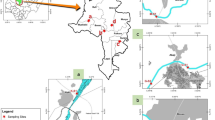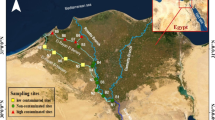Abstract
The relative contribution of sediment food (e.g. organic matter, carbohydrates, proteins, C, N, polyunsaturated fatty acids) and environmental variables (e.g. oxygen, pH, depth, sediment grain size, conductivity) in explaining the observed variation in benthic macroinvertebrates is investigated. Soft bottom sediments, water and benthic macroinvertebrates were sampled in several water systems across The Netherlands. The variance partitioning method is used to quantify the relative contributions of food and environmental variables in structuring the benthic macroinvertebrate community structure.It is assumed that detritivores show a significant relationship with sediment food variables and carnivores and herbivores do not. The results of the variance partitioning method with data sets containing only detritivores, herbivores or carnivores confirm this assumption. This indicates that the variance partitioning method is a useful tool for analyzing the impact of different groups of variables in complex situations. Approximately 45% of the total variation in the macroinvertebrate community structure could be explained by variables included in the analyses. The variance partitioning method shows that sediment food variables contributed significantly to the total variation in the macroinvertebrate dataset. The relative importance of food depends on the intensity of other environmental factors and is lower on broad spatial scales than on smaller scales.The results of the partitioning depend on the selected variables that are included in the analyses. The method becomes problematic in case variables from different groups of variables (e.g. one food variable and one environmental variable) have a high inflation factor and thus are collinear. The choice of the variable that is left out impacts the variance allocated to the different groups of variables.The variance partitioning method was able to detect the spatial scale dependent contribution of food variables in structuring macroinvertebrate communities. This spatial scale dependency can also be caused by the size, the composition, and the heterogeneity of the dataset. Performing extra analyses in which specific samples are removed from the original dataset can give insight in under- or overestimation of the impact of certain factors and offers the possibility to test the robustness of the obtained results.
Similar content being viewed by others
References
Ahlgren, G., W. Goedkoop, H. Markensten, L. Sonesten & M. Boberg, 1997. Seasonal variation in food quality for pelagic and benthic invertebrates in Lake Erken-the role of fatty acids. Freshwater Biology 38: 555–570.
Angermeier, P. L. & M. R. Winston, 1998. Local vs. regional influences on local diversity in stream fish communities of Virginia. Ecology 79: 911–927.
Bligh, E. G. & W. J. Dyer, 1959. A rapid method of total lipid extraction and purification. Canadian Journal of Biochemistry and Physiology 37: 911–917.
Borcard, D., P. Legendre & P. Drapeau, 1992. Partialling out the spatial component of ecological variation. Ecology 73: 1045–1055.
Brett, M. T. & D. C. Müller-Navarra, 1997. The role of highly unsaturated fatty acids in aquatic food web processes. Freshwater Biology 3: 483–499.
Chapman, P. M., B. Anderson, S. Carr, V. Engle, R.Green, J. Hameedi, M. Harmon, P. Haverland, J. Hyland, C. Ingersoll, E. Long, J. Rodgers Jr, M. Salazar, P. K. Sibley & H. Windom, 1997. General guidelines for using the sediment quality triad. Marine Pollution Bulletin 34: 368–372.
Clements, W. H. & P. M. Kiffney, 1993. Assessing contaminant effects at higher levels of biological organization. Environmental Toxicology and Chemistry 13: 357–359.
Dauwe, B., P. M. J. Herman & C. H. R. Heip, 1998. Community structures and bioturbation potential of macrofauna at four North Sea stations with contrasting food supply. Marine Ecology Progress Series 173: 67–83.
Dougherty, J. E., & M. D. Morgan, 1991. Benthic community response (primarily Chironomidae) to nutrient enrichment and alkalinization in shallow, soft water humic lakes. Hydrobiologia 215: 73–82.
Dubois, M., K. A. Gilles, J. K. Hamilton, P. A. Rebers & F. Smith, 1956. Colorimetric method for determination of sugars and related substances. Analytical Chemistry 18: 350–356.
Evaluatienota Water, 1994. Regeringsbeslissing. Aanvullende beleidsmaatregelen en financiering 1994-1998. Tweede Karmer, vergaderjaar 1993-1994, Kamerstuk 21250, nrs 27-28, The Netherlands.
Goedkoop, W. & R. K. Johnson, 1996. Pelagic-benthic coupling: Profundal benthic community response to spring diatom deposition in mesotrophic Lake Erken. Limnology and Oceanography 41: 636–647.
Goedkoop, W., L. Sonesten, H. Markensten & H. Ahlgren, 1998. Fatty acid biomarkers show dietary differences between dominant chironomid taxa in Lake Erken. Freshwater Biology 39: 101–109.
Guckert, J. B., C. P. Antworth, P. D. Nichols & D. C. White, 1985. Phospholipids, ester-linked fatty acid profiles as reproducible assays for changes in prokaryotic community structure of estuarine sediments. Microbial Ecology 31: 147–158.
Hellawell J. M. (1986) Biological indicators of freshwater pollution and environmental management. Elsevier, London, 546 pp.
Hill M. O. (1979) DECORANA-A FORTRAN program for detrended correspondence analysis and reciprocal averaging. Cornell University Ithaca, New York, 52 pp.
Hynes H. B. N. (1970) The ecology of running waters. Liverpool University Press, Liverpool, U.K., 555 pp.
Jackson, D. A., P. R. Peres Neto & J. D. Olden, 2001.What controls who is where in freshwater fish communities-the role of biotic, abiotic, and spatial factors. Canadian Journal of Fisheries and Aquatic Sciences 58: 157–170.
Kohler, S. L., 1992. Competition and the structure of a benthic stream community. Ecological Monographs 62: 165–188.
Levin, S. A., 1992. The problem of pattern and scale in ecology. Ecology 73: 1943–1967.
Luczak, C., M. Janquin & A. Kupka, 1997. Simple standard procedure for the routine determination of organic matter in sediments. Hydrobiologia 345: 87–94.
MacKay, R. J., 1992. Colonization by lotic macroinvertebrates: A review of processes and patterns. Canadian Journal of Fisheries and Aquatic Sciences 49: 617–628.
Macneil, C., J. T. A. Dick & R. W. Elwood, 1999. The dynamics of predation on Gammarus spp. (Crustacea: Amphipoda). Biological Reviews of the Cambridge Philosophical Society 74: 375–395.
Marsh, A. G. & K. R. Tenore, 1990. The role of nutrition in regulating the population dynamics of opportunistic, surface deposit feeders in a mesohaline community. Limnology and Oceanography 35: 710–724.
Menge, B. A. & A. M. Olson, 1990. Role of scale and environmental factors in regulation of community structure. Trends in Ecology and Evolution 5: 52–57.
Merritt, R. W. & K. W. Cummins, 1996. An introduction to the aquatic insects of North America. Third Edition. Kendall Hunt Publishing Company, Dubuque, Iowa, 862 pp.
Murphy, J. & J. P. Riley, 1962. A modified single-solution method for the determination of phosphate in natural waters. Analytica Chimica Acta 27: 31–36.
Napolitano, G. E., 1999. Fatty acids as trophic and chemical markers in freshwater ecosystems. In: Arts, M. T. & B. C. Wainman (eds), Lipids in freshwater ecosystems. Springer-Verlag, New York: 21–44.
Nusch, E. A. & G. Palme, 1975. Biologische Methoden für die Praxis der Gewässeruntersuchung. Gsf-Wasser/Abwasser 116: 562–565.
Peeters, E. T. H. M. & J. J. P. Gardeniers, 1998. Logistic regression as a tool for defining habitat requirements of two common gammarids. Freshwater Biology 39: 605–615.
Peeters, E. T. H. M., J. J. P. Gardeniers & A. A. Koelmans, 2000. Contribution of trace metals in structuring in situ macroinvertebrate community composition along a salinity gradient. Environmental Toxicology and Chemistry 19: 1002–1010.
Peeters, E. T. H. M., A. Dewitte, A. A. Koelmans, J. A. Van der Velden & P. J. Den Besten, 2001. Evaluation of bioassays versus contaminant concentrations in explaning the macroinvertebrate community structure in the Rhine-Meuse delta, The Netherlands. Environmental Toxicology and Chemistry 20: 2883–2891.
Phipps, G. L., V. R. Mattson & G. T. Ankley, 1995. Relative sensitivity of three freshwater benthic macroinvertebrates to ten contaminants. Archives of Environmental Contamination and Toxicology 28: 281–286.
Pinel-Alloul, B., T. Niyonsega & P. Legendre, 1995. Spatial and environmental components of freshwater zooplankton structure. Ecoscience 2: 1–19.
Pinel-Alloul, B., G. Méthot, L. Lapierre & A. Willsie, 1996. Macroinvertebrate community as a biological indicator of ecological and toxicological factors in Lake Saint-François (Québec). Environmental Pollution 91: 65–87.
Prus, T. M. Prus & P. Bijok, 1999. Diversity of invertebrate fauna in littoral of shallow Myczkowce dam reservoir in comparison with a deep Solina dam reservoir. Hydrobiologia 408/409: 203–210.
Reynoldson, T. B., R. C. Bailey, K. E. Day & R. H. Norris, 1995. Biological guidelines for freshwater sediment based on BEnthic Assessment of SedimenT (BEAST) using a multivariate approach for predicting biological state. Australian Journal of Ecology 20: 198–219.
Rice, D. L., 1982. The detritus nitrogen problem: new observations and perspectives from organic geochemistry. Marine Ecology Progress Series 9: 153–162.
Rodriguez, M. A. & P. Magnan, 1995. Application of multivariate analyses in studies of the organization and structure of fish and invertebrate communities. Aquatic Sciences. 57: 199–216.
Ter Braak, C. J. F., 1986. Canonical correspondence analysis: A new eigenvector technique for multivariate direct gradient analysis. Ecology 67: 1167–1179.
Ter Braak, C. J. F.& P. Smilauer, 1998. CANOCO Reference manual and user’s guide to Canoco for Windows: Software for Canonical Community Ordination (version 4).Wageningen: Centre for Biometry, Wageningen, The Netherlands, 351 pp.
Tolkamp, H. H., 1980. Organism-substrate relationship in lowland streams. Thesis Agricultural University Wageningen, The Netherlands, 211 pp.
Verdonschot, P. F. M., 1990. Ecologische karakterisering van oppervlaktewateren in Overijssel. Het netwerk van cenotypen als instrument voor ecologisch beheer, inrichting en beoordeling van oppervlaktewateren. Rijksinstituut voor Natuurbeheer, Leersum, The Netherlands (in Dutch).
Verdonschot, P. F. M. & C. J. F. Ter Braak, 1994. An experimental manipulation of oligochaete communities in mesocosms treated with chlorpyrifos or nutrient additions: multivariate analyses with Monte Carlo permutation tests. Hydrobiologia 278: 251–266.
Vos, J. H., P. J. Van den Brink, F. P. Van den Ende, M. A. G. Ooijevaar, A. J. P. Oosthoek, J. F. Postma & W. Admiraal, 2002. Growth response of a benthic detritivore to organic matter composition in sediments. Journal of the North American Benthological Society 21: 443–456.
Zalewski, M. & R. J. Naiman, 1984. The regulation of riverine fish communities by a continuum of abiotic-biotic factors. In: Alabaster J. S. (ed.) Habitat modification and freshwater fisheries. Batterworth Scientific Ltd., London, U.K., 3-9 pp.
Author information
Authors and Affiliations
Rights and permissions
About this article
Cite this article
Peeters, E.T., Gylstra, R. & Vos, J.H. Benthic macroinvertebrate community structure in relation to food and environmental variables. Hydrobiologia 519, 103–115 (2004). https://doi.org/10.1023/B:HYDR.0000026497.48827.70
Issue Date:
DOI: https://doi.org/10.1023/B:HYDR.0000026497.48827.70




